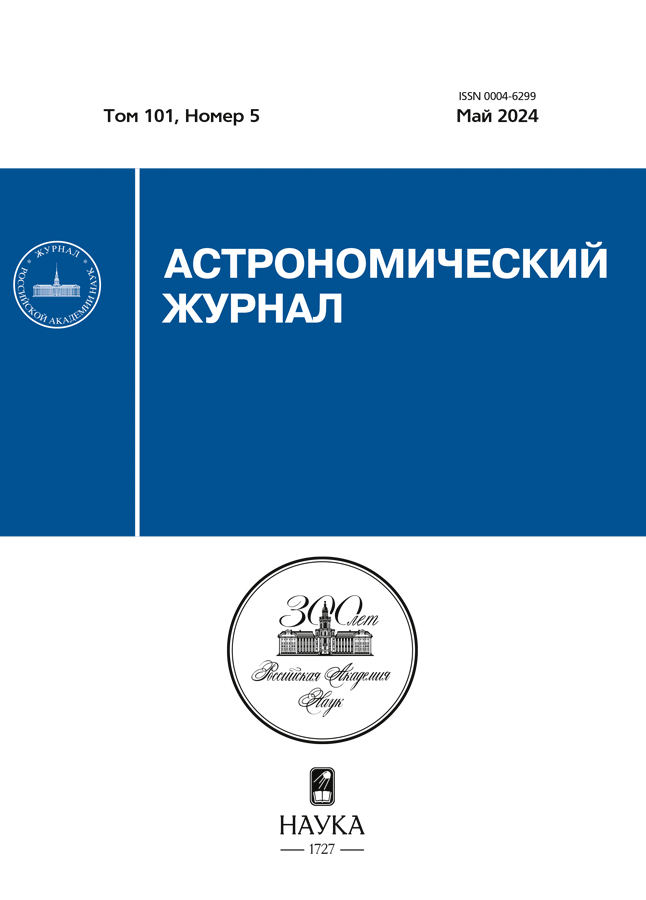Microstructure in Radio Emission of the Pulsar B1133+16 at a Frequency of 111 MHz
- Authors: Popov M.V.1
-
Affiliations:
- P. N. Lebedev Physical Institute of the Russian Academy of Sciences
- Issue: Vol 101, No 5 (2024)
- Pages: 455-468
- Section: Articles
- URL: https://rjmseer.com/0004-6299/article/view/647637
- DOI: https://doi.org/10.31857/S0004629924050051
- EDN: https://elibrary.ru/JNXCAY
- ID: 647637
Cite item
Abstract
This study is based on observations of the pulsar B1133+16 conducted on the BSA PRAO antenna array at a frequency of 111 MHz with continuous recording of undetected signal (voltage) in the 2.5 MHz band, providing time resolution 0.2 microseconds. From 30 observing sessions, 570 strong pulses were selected for the subsequent analysis of microstructure parameters. The analysis was performed by computing autocorrelation functions separately for the three components of the mean profile: two extreme main components I and II and for the central weak component S in the profile saddle. For the component S microstructure analysis was performed for the first time. Distributions have been constructed by the following parameters: time scales τµ, modulation depth mµ, and the parameter d, which characterizes the shape of the micropulses. Noticeable differences were found in some parameters for different profile components. The discovered features were interpreted in the model of hollow cone with a central component. It was believed that the radio emission of the extreme components (I and II) is generated by ordinary mode O, and the radio emission of the central component is provided by extraordinary mode X. Under this interpretation the radio emission output heights above the polar cap, were estimated to be 45 and 280 km for the X and O modes, respectively. A noticeable deformation of the X mode emission cone relative to the central component S was mentioned. Considerations are presented that point to the spatial structure of the secondary plasma flow, elongated along the meridians of the magnetic field.
Full Text
About the authors
M. V. Popov
P. N. Lebedev Physical Institute of the Russian Academy of Sciences
Author for correspondence.
Email: popov069@asc.rssi.ru
Russian Federation, Moscow
References
- D. R. Lorimer and M. Kramer, Handbook of Pulsar Astronomy (Cambridge, UK: Cambridge University Press, 2012).
- T. H. Hankins, 169, 487 (1971).
- T. H. Hankins and B. J. Rickett, in Methods in computational physics. Vol. 14. Radio astronomy (New York: Academic Press, Inc., 1975), p. 55.
- T. H. Hankins, 177, L11 (1972).
- J. M. Cordes and T. H. Hankins, Bull. Amer. Astron. Soc. 5, 18 (1973).
- V. Boriakoff, Pulsar Radiofrequency Observations with a Digital Pulsar Processor, PhD thesis (New York, Cornell University, 1973).
- J. M. Cordes, 208, 944 (1976).
- Н. С. Кардашев, А. Д. Кузьмин, Н. Я. Николаев, А. Ю. Новиков, и др., Астрон. журн. 55, 1024 (1978).
- М. В. Попов, Т. В. Смирнова, В. А. Согласнов, Астрон. журн. 64, 1013 (1987).
- M. V. Popov, N. Bartel, W. H. Cannon, A. Yu. Novikov, V. I. Kondratiev, and V. I. Altunin, Astron. and Astrophys. 396, 171 (2002).
- M. V. Popov and T. V. Smirnova, Astron. Rep. 68(5), 1129 (2024).
- I. A. Girin, S. F. Likhachev, A. S. Andrianov, M. S. Burgin, M. V. Popov, A. G. Rudnitskiy, V. A. Soglasnov, and V. A. Zuga, Astronomy and Computing 45, id. 100754 (2023).
- M. Kramer, R. Wielebinski, A. Jessner, J. A. Gil, and J. H. Seiradakis, Astron. and Astrophys. Suppl. Ser. 107, 515 (1994).
- B. J. Rickett, 197, 185 (1975).
- V. Radhakrishnan and D. J. Cooke, Astrophys. Letters 3, 225 (1969).
- J. M. Rankin, 274, 359 (1983).
- J. M. Rankin, 274, 333 (1983).
- J. M. Rankin, 301, 901 (1986).
- V. Radhakrishnan and J. M. Rankin, 352, 258 (1990).
- J. M. Rankin, 405, 285 (1993).
- V. S. Beskin, A. V. Gurevich, and Ia. N. Istomin, Astrophys. Space Sci. 146(2), 205 (1988).
- M. A. Ruderman and P. G. Sutherland, 196, 51 (1975).
- V. S. Beskin, Soviet Astron. 26, 443 (1982).
- В. С. Бескин, Успехи физ. наук 188(4), 377 (2018).
- P. A. Sturrock, 164, 529 (1971).
- A. G. Lyne and R. N. Manchester, Monthly Not. Roy. Astron. Soc. 234, 477 (1988).
- D. Mitra, M. Arjunwadkar, and J. M. Rankin, 806(2), id. 236 (2015).
- J. M. Cordes, 210, 780 (1976).
- Ya. Gupta, N. D. Ramesh Bhat, and A. Pramesh Rao, 520(1), 173 (1999).
- Т. В. Смирнова, В. И. Шишов, Письма в Астрон. журн. 15(3), 443
- M. V. Popov, N. Bartel, A. S. Andrianov, M. S. Burgin, et al., 954(2), id. 126 (2023).
- M. V. Popov and W. Sieber, Soviet Astron. 34, 471 (1990).
Supplementary files


















